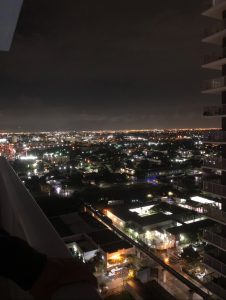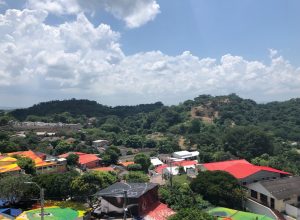Capturing Contrasts by Preston Costa
By: Preston Costa
The images were taken by my girlfriend, Jennifer. She’s tried to choose pictures that she has taken to show the contrasting differences between different areas of the world.
Miami – Picture 1

“Staring at a city that seems endless feels surreal, no matter how often I see it. Something about only seeing man-made sculptures and light pollution bouncing off the horizon seems… unnatural. There are no natural lakes or streams in sight, while trees and shrubs are kept at a minimum. Downtown Miami is massive, expensive, and bright. In this photo, it looked like a sea of traffic and lights. I remember being in complete awe when I first took it; the size of the city shocked me. It was almost as if I had just realized the scale of modern change in a single moment. Ok. Maybe not that dramatic, but it was overwhelming to look at. It’s almost as if I can hear the cars honking and people yelling through the photo. Add in the fact that I am at a less-than-desirable altitude, and this starts to feel like my worst nightmare.”
Miami is a massive city in South Florida occupied by millions of people. The image taken by Jenn captures just how massive and bright Miami really is from high above. You can actually see the light pollution in the sky slowly fading to black as you continue to look higher. To think about all the years and labor it took to build this city and all of its neighborhoods from the ground up is hard to grasp. Such an expensive and congested city to live in, the only thing I can think of is how overwhelming it must be to live in the middle of it.
Colombia – Picture 2

“A big contrast to the Miami picture, here is a small mountain town in Colombia that lives among the trees! The townspeople have painted their roofs with imagery of nature, including plants and animals. I initially took a photo because of how beautiful it all was: A sunny, blue sky and tree-covered mountains over colorful homes. Every time I look at this photo now, I think about how peaceful that day was. It was a reminder for me, especially after being in cities a lot, that the world isn’t always moving as fast as I think it is. I look at this photo now, and I’m able to relax, remembering the summer bugs that were out then. The only negative emotion I feel when staring at this is a twinge of longing, as I sometimes wonder if this slower and more personal life is more rewarding than the busy schedule Americans tend to have.”
Compared to the Miami photo, Jenn’s image of a small village in Colombia is quite the change. Everything is colorful and one with nature; peaceful would be the best word to describe it. I could imagine that the people living in this village truly respect the animals and nature around them. Another aspect I would like to point out is the sense of community in these small villages; everyone most likely knows who each other are, and from my experience, are a lot friendlier and open than most first world city people are.
Cigarettes – Picture 3

“Walking along the sidewalk, I came across multiple cigarettes ripped in half and scattered on the ground. Initially, I took a photo because I was puzzled, but I kept thinking about it for the rest of my walk. I grew up around a lot of smokers, and I would often have front row seats to fights and interventions over cigarettes. Watching someone fall into a nicotine addiction is as common as seeing a Publix in Florida. Even more upsetting is that stories of failed quitting attempts and relapses are just as common. I kept wondering if this was someone who got fed up with their habit and had a fit of rage. I wondered if it was a family member or loved one desperate to build space between cigarettes and whoever was smoking them. There are so many possibilities when you realize that over 23 million Americans are dependent on nicotine. It is an addiction that grabs a hold of you and doesn’t let go easily, so it made me happy to think that this was someone trying to change something for the better.”
In Jenn’s cigarette image, you can tell she stopped and had a contemplating moment about what she was seeing. From her experience of witnessing nicotine addiction, this moment was filled with personal emotions which drew her in to take this image. I think her speculations on why someone tore these cigarettes in half and threw them on the ground are interesting. Investigating the ideas of a rage against the habit or a family member trying to help their loved one in a desperate plea for distance between the smoker and their cigarettes. Addiction is a harsh disease to face, and this image captures the struggle in its fullest.
Overall, these images draw to one theme: the contrast between urban life and nature. She explores many topics in this theme with her writings and images she provided. Jenn captures the overwhelming cityscapes that is Miami and peaceful, natural environments in Colombia. In a poem by Seva Reilly titled “The World’s not our Lawn,” she writes, “The world is not our lawn full of grass we have grown.” This quote captures the contrast between nature and urbanization, stating that the world is not unnatural like how modern urbanization is trying to make it be. I think the poem is a perfect example of the difference between Colombians and Americans when it comes to their reaction to the nature around them; some embrace it, while others try to control it. The photos also highlight the impact they have on individuals while reflecting on the emotions felt at each scene. The theme also captures the human experience, touching on modern first world cities, the relaxing feeling found in nature, and struggles with addiction. Bringing all three images together, we can see a connection between urbanity, nature, and personal struggles to provide us with a perspective on the diversities of life.
Media Attributions
- IMG_6317
- IMG_6318
- IMG_6320

